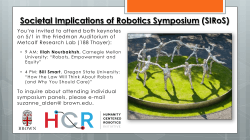
Press release - ISIR
Robots that can recover from damage in minutes Reference: Cully, A., Clune, J. Tarapore, D. and Mouret, J.-B. Robots that can adapt like animals. Nature, 521.7553, 2015. (cover story) Embargo: The content of this press release and the paper is embargoed until 1800 London time / 1300 US Eastern Time on 27 May 2015. Contacts: cully2015@listes.upmc.fr (all authors, preferred) & jean-baptiste.mouret@inria.fr (corresponding author) Videos and pictures: http://pages.isir.upmc.fr/~mouret/website/nature_press.xhtml Password protected: ID: ”nature”; password: ”cully2015” Robots will one day provide tremendous benefits to society, such as in search and rescue and putting out forest fires, but not until they can learn to keep working if they become damaged. A new paper in the journal Nature called “Robots that can adapt like animals” shows how to make robots automatically recover from injury in less than two minutes. A video of the work shows a six-legged robot that adapts to keep walking even if two of its legs are broken (https://youtu.be/T-c17RKh3uE). It also shows a robotic arm that learned how to correctly place an object even with several broken motors. Antoine Cully and Jean-Baptiste Mouret1 , from the Pierre and Marie Curie University in France, led the work in collaboration with Jeff Clune (University of Wyoming) and Danesh Tarapore2 (Pierre and Marie Curie University). In contrast to today’s robots, animals exhibit an amazing ability to adapt to injury. ere are many three-legged dogs that can catch frisbees, for example, and if your ankle is sprained you quickly figure out a way to walk despite the injury. e scientists took inspiration from these biological strategies. “When injured, animals do not start learning from scratch”, senior author Jean-Baptiste Mouret said. “Instead, they have intuitions about different ways to behave. ese intuitions allow them to intelligently select a few, different behaviors to try out, and aer these tests they choose one that works in spite of the injury. We made robots that can do the same.” Before it is deployed, the robot uses a computer simulation of itself to create a detailed map of the space of high-performing behaviors: is map represents the robot’s “intuitions” about different behaviors it can perform and their predicted value. If the robot is damaged, it uses these intuitions to guide a learning algorithm that conducts experiments to rapidly discover a compensatory behavior that works despite the damage. e new algorithm is called “Intelligent Trial and Error.” “Once damaged, the robot becomes like a scientist,” explains lead author Antoine Cully. “It has prior expectations about different behaviors that might work, and begins testing them. However, these predictions come from the simulated, undamaged robot. It has to find out which of them work, not only in reality, but given the damage. Each behavior it tries is like an experiment, and if one behavior doesn’t work the robot is smart enough to rule out that entire type of behavior and try a new type. For example, if walking mostly on its hind legs does not work well, it will next try walking mostly on its front legs. What’s surprising is how quickly it can learn a new way to walk. It’s amazing to watch a robot go from crippled and flailing around to efficiently limping away in about two minutes.” e same Intelligent Trial and Error algorithm allows robots to adapt to unforeseen situations, including adapting to new environments and inventing new behaviors. Jeff Clune explains that “technically, Intelligent Trial and Error involves two steps: (1) creating the behavior-performance map, and (2) adapting to an unforeseen situation.” e map in the first step is created with a new type of evolutionary algorithm called MAP-Elites. Evolutionary algorithms simulate Darwinian evolution by hosting “survival of the fittest” competitions in computer simulations to evolve artificially intelligent robots. e adaptation in the second step involves a “Bayesian optimization” algorithm that takes advantage of the prior knowledge provided by the map to efficiently search for a behavior that works despite the damage. “We performed experiments that show that the most important component of Intelligent Trial and Error is creating and harnessing the prior knowledge contained in the map,” Clune says. is new technique will help develop more robust, effective, autonomous robots. Danesh Tarapore provides some examples. “It could enable the creation of robots that can help rescuers without requiring their continuous attention,” he says. “It also makes easier the creation of personal robotic assistants that can continue to be helpful even when a part is broken.” is work has received funding by the Agence Nationale pour la Recherche (Creadapt, ANR-12-JS03-0009), the European Research Council (ResiBots, grant agreement No 637972) and a Direction Générale de l’Armement scholarship to A. Cully. 1 Now 2 Now research scientist at Inria (French Institute for Research in Computer Science and Automation), France. Marie Curie felllow at University of York, UK
© Copyright 2025


















